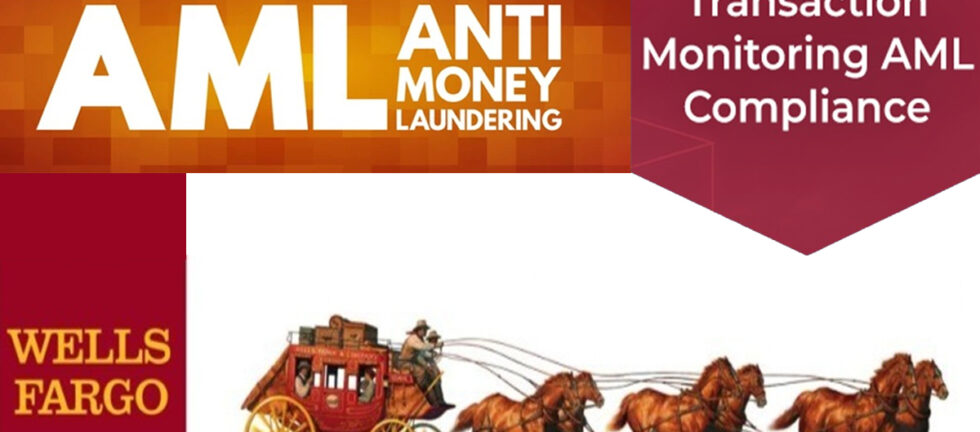The requirement to undertake transaction monitoring evolved because of anti-money laundering (AML) legislation and its importance has been magnified and reinforced by increased regulatory attention and significant fines.
Recently Wells Fargo unit fined $7M for AML transaction monitoring failures. For the second time in five years, a subsidiary of Wells Fargo has been charged by the Securities and Exchange Commission (SEC) with failing to file suspicious activity reports (SARs) in a timely manner due to deficiencies in the system it used to flag transactions. Wells Fargo Advisors, a brokerage firm owned by Wells Fargo, failed to promptly file 34 SARs from 2017-21
In 2017, Wells Fargo Advisors settled charges with the SEC for similarly failing to file at least 50 SARs in a timely manner by paying a $3.5 million fine.
WHAT IS AML TRANSACTION MONITORING?
AML transaction monitoring refers to the process of monitoring customer transactions. In this process, both historical and current customer interactions are monitored so that a complete picture of customer activity can be built. Although this process can be done manually, it is incredibly time consuming. For this reason, most financial institutions and large DNFBPs use software.
AML TRANSACTION MONITORING AND KYC
The AML transaction monitoring process ensures that you know exactly who your customers are. It also ensures that you do not fall foul of the latest AML and KYC requirements.
A transaction monitoring system uses information gained from the KYC processes of your business to account for client risk. These risk measures are then used as part of the rules that help identify certain account-based activities for investigation and possible disclosure.
WHO NEEDS TRANSACTION MONITORING?
In the UAE Ongoing monitoring is a compliance requirement as per Federal Decree by Law No (20) of 2018 on Anti-Money Laundering and Combatting the Financing of Terrorism (AML-CFT).
Business activities which fall under DNFBPs or Financial institutions, are required to implement a robust ongoing monitoring program. It involves following processes:
- Identifying the objective and nature of changing business relationships and record-keeping
- Reassessment of risk associated with customers in terms of activities, transactions geographies, and updates to the PEP and Sanctions database
- Determining whether the customer profile matches with the KYC and customer risk assessment
An ongoing monitoring process helps to periodically review the changes in the PEP status, sanctions, and adverse media reports.
BAD PRACTICES IN IDENTIFYING DEFICIENCIES IN TRANSACTION MONITORING
The Financial Conduct Authority’s (FCA) “Financial Crime Guide” provides the following examples of bad practice:
- The firm fails to take adequate measures to understand the risk associated with the business relationship and is therefore unable to conduct meaningful monitoring.
- The MLRO (money laundering reporting officer) can provide little evidence unusual transactions are brought to their attention.
- Staff always accept a customer’s explanation for unusual transactions and do not probe further.
The above examples highlight the importance of staff having the knowledge and confidence to challenge transactions while maintaining a degree of professional skepticism.
HOW TO DIAGNOSE THE HEALTH OF THE AML TRANSACTION MONITORING
One can use the checklist below for an early “diagnosis” of the health of the transaction monitoring framework and to identify existing and emerging risk exposure.
- Is there a documented risk assessment which considers transactions risk?
- Has the MLRO conducted targeted training to encourage staff to report any unusual or suspicious transactions?
- Are policies and procedures fit for purpose?
- Is there comprehensive training delivered to alert handlers?
- Is there an adequate assurance program in place, proportionate to the scale and complexity of the firm?
- Does this consider elements like appropriateness of system calibration and record-keeping?
FIVE CONSIDERATIONS FOR A TRANSACTION MONITORING SYSTEM
Below are five key considerations for anyone managing or working within transaction monitoring.
- Identify and document the correct transaction monitoring approach according to business model and strategy. Culture, education, and training are key in preventing financial crime.
- Transaction monitoring systems should be clear and understandable. System should be updated to include a rapidly changing transaction environment, such as the unprecedented sanctions changes we’re currently experiencing.
- An effective transaction monitoring system may employ an automated approach but will still rely on a certain level of manual, human intervention to review potential issues identified.
- Electronic financial transactions provide new ways of money laundering for criminals. Anti-money laundering compliance regulations and transaction monitoring play a key role in detecting increasingly complex financial criminal activity and must be reviewed and updated regularly.
- Traditionally, the focus of transaction monitoring systems has been on numbers: values, volumes, and frequency. However, other data, such as known high-risk money laundering addresses and corporations, should also be factored in. Numbers constantly change, but corporate names and addresses tend to remain static and are a more reliable search component.
AML TRANSACTION MONITORING BEST PRACTICES
Firms use a blend of manual and automated systems, depending on the volume and complexity of the transactions they process, their risk appetite, and their level of maturity. Many effective transaction monitoring approaches that employ an automated approach do still rely on some level of human intervention. This ensures that:
- The scope of transaction monitoring is monitored
- The systems and the rules in operation are monitored and updated
- The potential issues identified are reviewed regularly
- Legal and regulatory requirements are fulfilled
- Reporting is provided to senior managers and regulators
- Assurance activities that are proportionate to the scale and complexity of the organization are undertaken regularly
WHAT DOES AML TRANSACTION MONITORING DETECT?
AML transaction monitoring is an effective way for DNFBPs and financial institutions to combat crime and comply with AML/CFT regulations. It can be used to detect, Money laundering, Terrorist financing, Fraud, Drug trafficking, Bribery, Corruption, and identity theft.

Alia Noor (FCMA, CIMA, MBA, GCC VAT Comp Dip, Oxford fintech programme, COSO Framework)
Associate PartnerAhmad Alagbari Chartered Accountants






